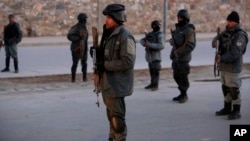An American watchdog says Afghan national security forces lost about 7,000 personnel in the first 11 months of 2016 and the U.S.-backed government controls less than 60 percent of the country.
The findings are part of a new quarterly report the Special Inspector General for Afghanistan Reconstruction John Sopko released Wednesday, after submitting it to the U.S. Congress.
"The numbers of the Afghan security forces are decreasing, while both casualties and the number of districts under insurgent control or influence are increasing,” according to the report, though Afghan defense ministry officials immediately questioned it.
The Special Inspector General for Afghanistan Reconstruction is tasked to detect waste, corruption and mismanagement in the $117 billion Washington has invested in the war-ravaged country since 2002.
More than half of the money has been spent on building and training Afghan National Defense and Security Force (ANDSF) personnel.
“From January 1, 2016, through November 12, 2016, according to figures provided by the Afghan government to USFOR-A (U.S. Forces Afghanistan), 6,785 ANDSF service members were killed and an additional 11,777 members were wounded,” the report noted.
Citing U.S. military assessments, it said that approximately 57.2 percent of 407 Afghan districts are under government control or influence, showing a nearly 15 percent decrease since November 2015. The number of districts under insurgent control or influence rose to 10.1 percent while the rest are contested, the report added.
It cited Uruzgan and Helmand as among the most contested provinces, where five out of six districts and eight of 14 districts respectively are under insurgent control or influence.
Afghan Defense ministry disagrees
Defense ministry spokesman, Dawlat Waziri, disagreed with the report findings, claiming the government is in control of all 34 provinces and last year’s casualty toll was not different from 2015, when U.S. military said around 5,000 personnel were killed.
“The figures shown in the report are not correct. Certainly there were more losses in 2015 and 2016, compared to 2014 and you are aware of the reasons. But the report and statistics shown in it are completely incorrect and not factual,” Waziri told VOA.
Most of the U.S.-dominated international forces left Afghanistan in late 2014, allowing newly trained ANDSF to take control of the counterinsurgency operations.
Waziri justified the battlefield losses, saying the fighting in Afghanistan intensified only after foreign forces withdrew from the country. But he vowed Afghan forces will show more progress in 2017 because of their experience and better performance in the previous year.
SIGAR’s report, however, acknowledged that Afghan President Ashraf Ghani’s national unity government’s anti-corruption campaign has led to a noticeable drop in corruption when procuring goods and services.
The quarterly report is the first since President Donald Trump took office January 20. Sopkoo observed it was a good opportunity for the new administration to reflect on the Afghan reconstruction mission.
The report also warned drug production continued to proliferate in Afghanistan and the U.S. mission will face challenges unless the issue is tackled, because the Taliban insurgency is largely benefiting from the illicit narcotic income.










